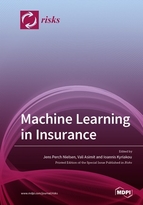Machine Learning in Insurance
A special issue of Risks (ISSN 2227-9091).
Deadline for manuscript submissions: closed (31 December 2019) | Viewed by 56102
Special Issue Editors
Interests: machine learning in insurance; structured nonparametric statistics; pension research
Interests: numerical methods: transform techniques and Monte Carlo simulation; stochastic asset modelling; exotic derivatives; commodity markets; actuarial science
Special Issue Information
Dear Colleagues,
Machine learning is a relatively new field without a unanimous definition. It is well-accepted that machine learning is a combination of computational methods and validation of prediction methods. The latter are often statistical prediction methods, however other methods exist. Additionally, machine learning methods might be ad hoc and closely connected to the application at hand. To create ad hoc prediction methods, the machine learner needs to draw on experience and knowledge of everything surrounding the case at hand. It is not enough to define a simple performance measure without further explanation, such a measure needs to be aligned with the needs of the client, sponsor or who-ever ordered the study in the first place. In many ways, actuaries have been machine learners. In both pricing and reserving, and also more recently in capital modeling, actuaries have combined statistical methodology with a deep understanding of the problem at hand and how any solution may affect the company and its customers. One aspect that has perhaps not been so well-developed among actuaries is validation. Discussions among actuaries’ “preferred methods” were often without solid scientific arguments, including validation of the case at hand. Our criteria for this Special Issue are to promote a good practice of machine learning in insurance considering the following three key issues: a) Who is the client or sponsor or otherwise interested real-life target of this study? b) The reason for working with this particular data set and a clarification of available extra knowledge – that we also call prior knowledge—besides the data set alone. c) A mathematical statistical argument for the validation procedure. In other words, a critical question to be answered is how prior knowledge fits with the data set in a correct mathematical statistical model.
Notice that we do not consider any statistical methods to be more “machine learning” than others. Therefore, a logistic regression method or a generalized linear model may both be the final choice of machine learning.
Moving from these considerations, this Special Issue aims to compile high quality papers that offer a discussion of the state-of-the-art developments or introduce new theoretical or practical advances in this field. We welcome papers related, but not limited to, the following topics:
- Modeling of capital requirement for Life or Non-Life Underwriting Risk
- Modeling extensions of Solvency II Standard formula
- Pricing methodology in non-life insurance
- Reserving methodology in non-life insurance
- Any other data-driven modeling procedure relevant in non-life or life insurance, including marketing applications or price elasticity investigations.
Prof. Dr. Jens Perch Nielsen
Dr. Vali Asimit
Dr. Ioannis Kyriakou
Guest Editors
Manuscript Submission Information
Manuscripts should be submitted online at www.mdpi.com by registering and logging in to this website. Once you are registered, click here to go to the submission form. Manuscripts can be submitted until the deadline. All submissions that pass pre-check are peer-reviewed. Accepted papers will be published continuously in the journal (as soon as accepted) and will be listed together on the special issue website. Research articles, review articles as well as short communications are invited. For planned papers, a title and short abstract (about 100 words) can be sent to the Editorial Office for announcement on this website.
Submitted manuscripts should not have been published previously, nor be under consideration for publication elsewhere (except conference proceedings papers). All manuscripts are thoroughly refereed through a single-blind peer-review process. A guide for authors and other relevant information for submission of manuscripts is available on the Instructions for Authors page. Risks is an international peer-reviewed open access monthly journal published by MDPI.
Please visit the Instructions for Authors page before submitting a manuscript. The Article Processing Charge (APC) for publication in this open access journal is 1800 CHF (Swiss Francs). Submitted papers should be well formatted and use good English. Authors may use MDPI's English editing service prior to publication or during author revisions.
Keywords
- machine learning
- risk analysis
- volatility
- insurance
- client
- audience
- validation
- domain knowledge
- prior knowledge
- statistical model







